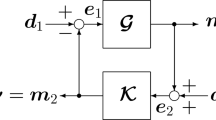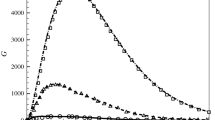Abstract
A reduced-order linear feedback controller, which is used to control the linear disturbance in two-dimensional plane Poiseuille flow, is applied to a boundary layer flow for stability control. Using model reduction and linear-quadratic-Gaussian/loop-transfer-recovery control synthesis, a distributed controller is designed from the linearized two-dimensional Navier-Stokes equations. This reduced-order controller, requiring only the wall-shear information, is shown to effectively suppress the linear disturbance in boundary layer flow under the uncertainty of Reynolds number. The controller also suppresses the nonlinear disturbance in the boundary layer flow, which would lead to unstable flow regime without control. The flow is relaminarized in the long run. Other effects of the controller on the flow are also discussed.
Similar content being viewed by others
Abbreviations
- A,B,C,D:
-
Matrices associated with state-space equation
- \(\hat A,\hat B,\hat C,D\) :
-
Matrices associated with reduced-order state-space equation
- A c :
-
Loop coefficient matrix
- A f :
-
Matrix associated with error evolution equation
- A m :
-
Amplitude of disturbance
- a mn,bmn,Cmn,dmn :
-
Coefficients of spectral decomposition
- eα:
-
Error between internal state\(\hat x_\alpha \) and estimate state\(\tilde x_\alpha \)
- F:
-
Matrix associated with cost criterion
- g :
-
Forcing term in Navier-Stokes equation
- h :
-
half channel height
- I:
-
Identity matrix
- \(\hat K_\alpha \) :
-
Control gain matrix
- L :
-
4th order operator for linear term
- L x :
-
Horizontal length
- \(\hat L_\alpha \) :
-
Kaiman gain matrix
- N :
-
4th order operator for nonlinear term
- N a :
-
Matrix associated with cost criterion,\(\hat C_\alpha ^T \)
- P :
-
Pressure
- P α :
-
Conditional error variance
- Q α :
-
Matrix associated with cost criterion,\(\hat C_\alpha ^T \hat C_\alpha \)
- R α :
-
Matrix associated with cost criterion, Dα T αDα+FTαFα
- Re:
-
Real part of complex number
- Re :
-
Reynolds number based on half channel height
- Re δ* :
-
Reynolds number based on displacement thickness
- S α :
-
Solution of algebraic Riccati equation
- t :
-
time
- U :
-
Mean velocity in Poiseuille flow
- U b :
-
Blasius mean velocity
- U:
-
Input vector
- U :
-
Disturbance velocity
- \(\hat u(y)\) :
-
Eigenfunction of Orr-Sommerfeld solution
- ũ:
-
Intermediate velocity
- υ w :
-
Blowing/suction at wall
- V, W:
-
Power spectral density of v and w
- v, w:
-
White Gaussian noise associated with LQG
- x :
-
State-space vector
- \(\hat x\) :
-
Reduced-order state space vector
- \(\tilde x\) :
-
Conditional mean estimate of\(\hat x\)
- x, y :
-
Physical coordinate
- y max :
-
Height of physical domain of boundary layer flow
- Z t :
-
Measurement history
- z:
-
Output vector
- z :
-
Wall-shear measurement
- α :
-
Wavenumber
- αlβlγl,Sl :
-
Coefficients associated with RK3
- β},ρ :
-
Tuning parameter for LQG/LTR
- Γ α :
-
Input matrix associated with LQG problem
- Γ m :
-
Combination of Chebyshev polynomial
- Δ :
-
Laplacian operator
- δ * :
-
Displacement thickness
- δ i, :
-
Kronecker delta function
- T:
-
Cost criterion
- ψ :
-
Streamfunction
- η max :
-
Height of computational domain of boundary layer flow
- φ :
-
Pseudo pressure
- σ :
-
Parameter to determine the grid concentration
- υ :
-
Kinematic viscosity
- σ α :
-
Filter residual
- ω :
-
Eigenvalue of Orr-Sommerfeld solution
- n :
-
Time step
- i, j :
-
Index representing horizontal and wall-normal direction ( = 1, 2)
- n :
-
Wavenumber index
- l :
-
RK substep ( = 1, 2, 3)
References
Akhavan, R., Jung, W. J. and Mangiavacchi, N., 1993, “Turbulence Control in Wall-Bounded Flows by Span wise Oscillations,”Appl. Sci. Res., Vol. 51, p. 299.
Berger, T., Lee, C., Kim, J. and Lim, J., 2000, “Turbulent Boundary Layer Control Utilizing the Lorentz Force,”Phys. Fluids, Vol. 12, No. 3, p. 631.
Bewley, T. and Liu, S., 1998, “Optimal and Robust Control and Estimation of Linear Paths to Transition,”J. Fluid Mech. Vol. 365, p. 305.
Bewley, T. and Moin, P., 1994, “Optimal Control of Turbulent Channel Flow,”ASME Conference, ASME DE-Vol. 75.
Choi, H. Moin, P. and Kim, J., 1994, “Active Turbulence Control for Drag Reduction in Wall-Bounded Flows,”J. Fluid Mech., Vol. 262, p. 75.
Choi, H., Temam, R., Moin, P. and Kim, J., 1993, “Feedback Control for Unsteady Flow and Its Application to the Stochastic Burgers Equation, ”J. Fluid Mech., Vol. 253, p. 509.
Cortelezzi, L. and Speyer, J. L., 1998, “Robust Reduced-Order Controller of Laminar Boundary Layer Transitions,”Phys. Rev. E, Vol. 58, No. 2, p. 1906.
Cortelezzi, L., Lee, K. H., Kim, J. and Speyer, J. L., 1998, “Skin-Friction Drag Reduction via Robust Reduced-Order Linear Feedback Control,”Int. J. Comp. Fluid Dyn., Vol. 11, No. 1-2, p. 79.
Door, F. W., 1970, “The Direct Solution of the Discrete Poisson Equation on a Rectangle,”SIAM Rev., Vol. 12, p. 248.
Door, F. W., 1973, “Direct Methods for the Solution of Poisson ’s Equation on a Staggered Grid,”J. Computational Physics, Vol. 12, p. 422.
Doyle, J. C. and Stein, G., 1981, “Multivariable Feedback Design: Concepts for a Classical/Modern Synthesis,”IEEE Trans. on Automatic Control, AC-26(2).
Gad-el-Hak, M. and Bushnell, D.M., 1991, “Separation Control: Review,”Journal of Fluids Engineering, Vol. 113, p. 5.
Gad-el-Hak, M., 1994, “Interactive Control of Turbulent Boundary Layer-A Futuristic Overview,”AIAA Journal, Vol. 32, No. 9, p. 1753.
Gad-el-Hak, M., 1989, “Flow Control,”Applied Mechanics reviews, Vol. 42, No. 10, p. 261.
Joshi, S., Speyer, J. L., and Kim, J., 1995,Proc. 34th Conference on Decision and Control, New Orleans, Louisiana.
Joshi. S., Speyer, J. L. and Kim, J., 1997, “A Systems Theory Approach to the Feedback Stabilization of Infinitesimal and Finite-Amplitude Disturbances in Plane Poiseuille Flow,”J. Fluid Mech., Vol. 332, p. 157.
Joshi, S., Speyer, J. L. and Kim, J., 1999, “Finite Dimensional Optimal Control of Poiseuille Flow,”J. Guidance, Control, and Dynamics, Vol. 22, No. 2.
Kim, J. and Moin, P., 1985, “Application of a Fractional-Step Method to Incompressible Navier-Stokes Equations,”J. Computational Physics, Vol. 59, p. 308.
Koumoutsakos, P., 1999, “Vorticity Flux Control for a Turbulent Channel Flow,”Phys. Fluids, Vol. 11, No. 2, p. 248.
Laurien, E. and Kleiser, L., 1986, “Numerical Simulation of Boundary-Layer Transition and Transition Control,”J. Fluid Mech., Vol. 199, p. 403.
Lee, C., Kim, J., Bobcock, D. and Goodman, R., 1997, “Application of Neural Networks to Turbulence Control for Drag Reduction,”Phys. Fluids, Vol. 9, No.6, p. 1740.
Lee, Keun H., 1999, “A System Theory Approach to Control of Transitional and Turbulent Flows,” Ph. D. dissertation, Dept. of Mechanical Eng. Univ. of California, Los Angeles, CA.
Lee, Keun H., Cortelezzi, L., Kim. J. and Speyer, J. L., 2001, “Application of Robust Reduced-Order Controller to Turbulent Flows for Drag Reduction,”Phys. Fluids, Vol. 13, No. 5, p. 1321.
Lele, S. K., 1991, “An Improvement of Fractional Step Methods for the Incompressible Navier-Stokes Equations,”J. Computational Physics, Vol. 92, p. 369.
Lele, S. K., 1992, “Compact Finite Difference Schemes with Spectral-like Resolution,”J. Computational Physics, Vol. 103, p. 16.
Lim, J. and Kim, J., 2000, “A Linear Process in Wall-Bounded Turbulent Shear Flows,”Phys. Fluids, Vol. 12, No. 8, p. 1885.
Modi, V. J., 1997, “Moving Surface Boundary-Layer Control: A Review,”Fluids and Structures, Vol. 11, No. 6, p. 627.
Reed, H. L., Saric, W. S. and Arnal, D., 1996, “Linear Stability Theory Applied to Boundary Layers,”Annu. Rev. Fluid Mech., Vol. 28, p. 389.
Rhee, I. and Speyer, J. L., 1991, “A Game Theoretic Approach to a Finite Time Disturbance Attenuation Problem,”IEEE Trans., Automatic Control, Vol. 36, No. 9, p. 1021.
Schumann, U. and Sweet, R. A., 1988, “Fast Fourier Transforms for Direct Solution of Poisson’s Equation with Staggered Boundary Conditions,”J. Computational Physics, Vol. 75, p. 123.
Zang, T. A. and Hussaini, M. Y., 1985, “Numerical Experiments on Subcritical Transition Mechanisms,”AIAA Paper, 85-0296.
Zhou, K., Doyle, J. C. and Glover, K., 1996, Robust and Optimal Control, Prentice Hall.
Author information
Authors and Affiliations
Corresponding author
Rights and permissions
About this article
Cite this article
Lee, K.H. Control of boundary layer flow transition via distributed. KSME International Journal 16, 1561–1575 (2002). https://doi.org/10.1007/BF03021658
Received:
Revised:
Issue Date:
DOI: https://doi.org/10.1007/BF03021658




